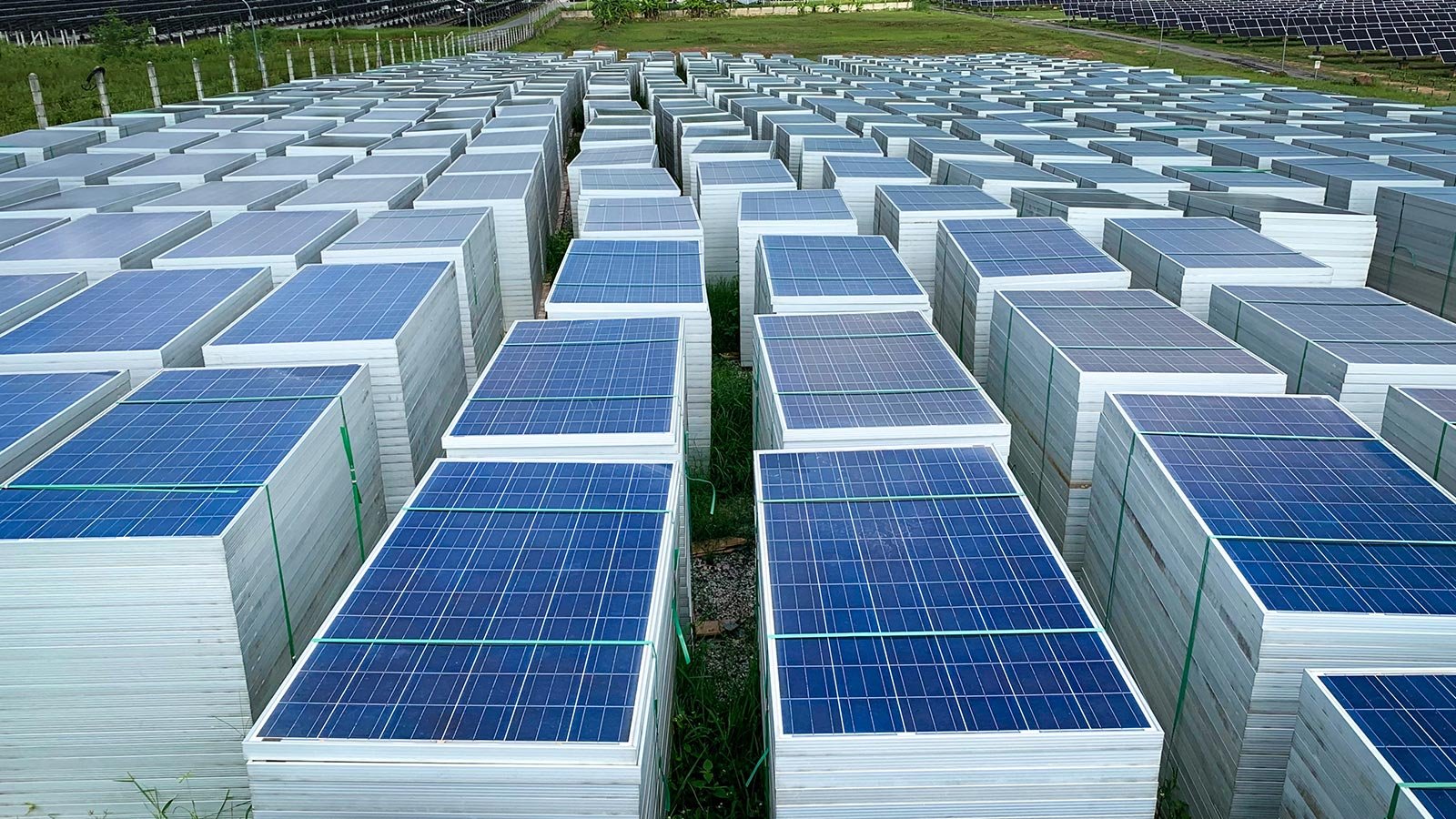In the town of Pukuka tucked away amidst the bush near Yei, South Sudan, Fatema prepares a meal for her husband and three children. To make a meal is a multi-hour process for Fatema, whose home is a grass hut known as a tukul with no electricity or running water. 
Early in the morning, she leaves to fetch clean water from a well a few kilometers away. Then, she’s off to the open-air market to buy food, but only enough for the family can consume that meal, as she has no way of storing left-overs. Back home, she lights her cooking fire over a coal pit. In 2-3 hours, the food will be ready. She’ll begin this same process in the afternoon once again to prepare the family’s dinner.
Is this all there is for Fatema, or could one simple change make a difference? A secondhand solar system would improve the quality of life for Fatema and her family. Additionally, it would empower Fatema to retire her use of coal and become part of the solution to save our planet. Going beyond single-home use, a microgrid constructed of secondhand modules paired with a second-life battery would improve the lives of Fatema's entire community.
The Case for Reuse
For much of the human population living in developed countries, it is common practice to buy a new product, use it, and dispose it when we no longer want it. But there are a number of commodities that have lifespans beyond one owner’s use. Goods like cars, homes, clothing, cell phones, computers, and yes, solar panels too, typically change ownership hands at least once before they are at end-of-life.
Reuse is critical for the welfare of the environment and humanity, especially when it comes to solar energy. According to World Bank, some 759 million people lack access to electricity. That number increases to 3.5 billion people, nearly half of the global population, who lack reasonably reliable access to electricity.
This issue spans beyond undeveloped populations. Income disparities and weather crises affect people’s access to reliable electricity in every country throughout the world, regardless of how well developed a grid system may be.
Meanwhile, the need persists to rapidly transition to clean energy sources, as our planet’s atmospheric carbon dioxide has dramatically increased since 1950. Reusable solar panels add to the mix of solutions toward carbon reduction.
Yet, Good Sun, a non-profit located in Grass Valley, California, estimates millions of functioning solar panels flow to landfill sites every year. The keyword here is - functioning.
“Waste panels often aren’t waste,” states Adam Minter, author and journalist for Bloomberg Opinion. “They’re just degraded by time in the sun or less efficient than newer models. They may not be good enough for San Francisco homeowners and cutting-edge utilities, but they work perfectly well for anyone in a sunny climate in need of stable, off-grid power who doesn’t want to [or can’t] pay full price.”
Clearly, there is an immediate need to redistribute these goods. Responding to the need benefits both people and the planet. How do we ensure such modules make their way to those who can use them today instead of to landfills?
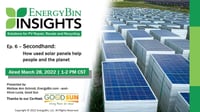 Watch on demand our webinar - Secondhand: How used solar panels help people and the planet.
Watch on demand our webinar - Secondhand: How used solar panels help people and the planet.
Used solar panels are part of the solution
There are two main ways to redistribute still-viable solar panels to communities in need – via resale or making donations.
Resale
You may be wondering whether there’s a market for second-hand solar panels. From EnergyBin’s experience, the answer is yes, and demand for such material is booming.
To give an example, just last month on the B2B exchange platform, a member listed 180,000 used Tier 1 modules for resale. The degraded power amounted to 50 megawatts, as tested by the seller. The listing price was $0.085 per watt. Within a week’s time, the seller had multiple “take-all” bids and settled with a buyer, who paid $0.14 per watt.
Resellers typically quote used module prices 50-75% less than new modules. In the latest PV Module Price Index presented by EnergyBin, a report that tracks crystalline-silicon module prices within the secondary market, the average price ranged from $0.010 to $0.630 per watt for used modules between 185 and 445 watts.
Some second-hand modules that appear for resale on EnergyBin are less than five years old. For example, this image shows 3.1 megawatts of used Tier 1, 335-watt, 72-cell, 1500-volt poly solar panels less than two years old. They were listed for sale in 2021 after the property was sold. The offer price was $0.25 per watt.
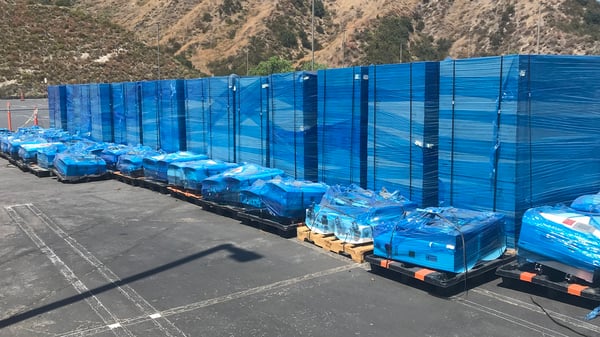
Global demand for equipment rated for the United States market is extremely high because the quality of second-hand material from the U.S. is often better than that of new material available for sale in some developing countries.
“Within days after second-hand modules for sale are listed on our exchange, they tend to be purchased, which gives insight into the high demand for quality used modules,” says Renee Kuehl, Director of Sales & Marketing at EnergyBin. “If there wasn’t strong demand, we wouldn’t see this material moving.”
Secondary market prices tend to fluctuate. The ebbs and flows are primarily due to increasing demand for secondhand solar modules. Pricing often depends on the location of the buyer. Some sellers factor in age of panels, the number of busbars, the number of cells, and labeled wattage to assess and calculate their offer price. However, because there is no global baseline price, many sellers use an auction service to attract the highest offer.
To determine if your used PV modules have resale value, take the following steps:
- Inspect the modules for any damage. If the glass is broken, then proceed with recycling.
- Test the modules to determine the degradation rate, and verify amp and voltage performance levels.
- Work with an appraiser or reputable reseller, who can provide a valuation of the modules.
Contact EnergyBin for assistance with listing used solar panels for resale on our B2B exchange platform.
Making Donations
The other option to redirect used solar panels away from landfills and toward those who can use them today is to make a donation. There are a number of public charities that take donations.
EnergyBin partners with Good Sun, a U.S. federally-registered 501(c)(3) public charity and California state-registered domestic non-profit, to provide opportunities for solar companies and individuals to donate.
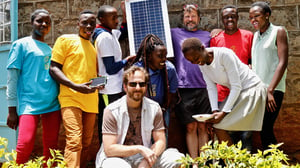 To date, Good Sun has served over 2,000 low-middle income families and has diverted over 150,000 pounds of solar panels away from landfills via re-installation. The organization has provided over $300,000 in materials and monetary donations to other non-profits and disaster relief efforts.
To date, Good Sun has served over 2,000 low-middle income families and has diverted over 150,000 pounds of solar panels away from landfills via re-installation. The organization has provided over $300,000 in materials and monetary donations to other non-profits and disaster relief efforts.
Good Sun accepts modules for donation that are producing at least 50% of their rated power. Equipment donors should be prepared to show evidence that secondhand modules have been tested and are in good working order.
Cash donations are also welcomed as they increase Good Sun’s buying power to purchase quality second-hand modules for the people they serve. Cash donations coupled with equipment donations propel Good Sun forward to scale up their impact.
Good Sun works with a number of partners to bring solar energy to underserved communities. This year, they are focusing their work with Habitat for Humanity to install rooftop solar PV systems on 40 homes. In addition, they are poised to donate a 30 kilowatt solar system to a northern California watershed protection organization through a business model of non-profits helping non-profits.
Past projects include solar installations at three charter schools in Nevada County, classroom construction and solarization at the Queen Elizabeth Nursery & Primary School in Uganda, solar back-up systems for the CURA Orphanage in Kenya and the Buhoma Hospital in Uganda, and solar for the Hospitality House homeless shelter in Grass Valley, California.
The brevity of these projects illustrates the need, in a variety of scenarios and locations, for reliable access to electricity and a response to that need.
Donations make it possible for organizations like Good Sun to provide opportunities in equal measure to communities in need while working to hasten the transition to a global clean-energy economy.
Learn more about Good Sun.
The bottom line
The reallocation of functioning secondhand solar panels is good for humanity and the planet. Resale and making donations are two primary options for dealing with unwanted still-viable modules.
The worst choice you can make when it comes to secondhand solar panels is to dump them in landfills. The best (and most responsible) choice you can make is to redistribute them to those who can use them today.
More Resources:
 The Ultimate Guide to Selling Wholesale Solar Equipment
The Ultimate Guide to Selling Wholesale Solar Equipment
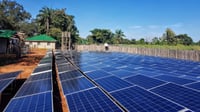 Repair, Resell or Recycle - What to Do With Used Solar Panels
Repair, Resell or Recycle - What to Do With Used Solar Panels
